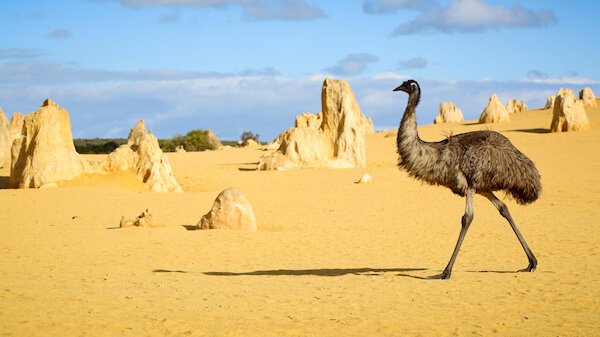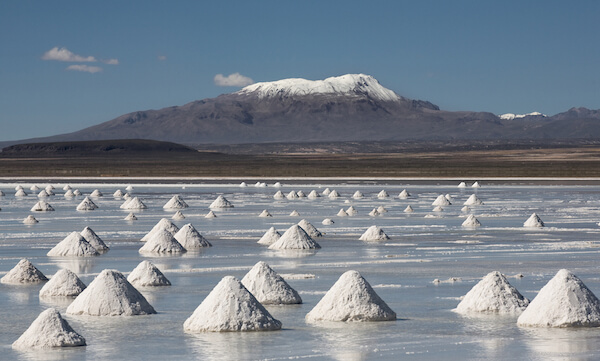We are about to begin Lent, the solemn season in which the Church unites herself to what the Catechism calls “the mystery of Jesus in the desert” (#540). As we approach this season of preparation, I would like to draw your attention to Pope Francis’ advice in his Lenten Message to immerse yourself in God’s word, which sustains us in times of temptation and helps us hear God’s voice more clearly.
In his Tractates on the First Letter of John, St. Augustine provides us with an analogy that is helpful for understanding how God works in desolate times. He writes, “Suppose you are going to fill some holder or container, and you know you will be given a large amount. Then you set about stretching your sack or wineskin or whatever it is. Why? Because you know the quantity you will have to put in it and your eyes tell you there is not enough room. By stretching it, therefore, you increase the capacity of the sack, and this is how God deals with us. Simply by making us wait he increases our desire, which in turn enlarges the capacity of our soul, making it able to receive what is to be given to us” (emphasis added).
The spiritual life is about opening our hearts to receive the love, compassion and mercy of the Father, Jesus and the Holy Spirit. When we encounter trials in our spiritual life, God is enlarging the capacity of our hearts and souls to receive more.
After Jesus had spent 40 days and nights fasting and praying in the desert, he responded to Satan’s temptations by placing his trust in God the Father, underscoring his commitment with Scripture. The Evil One tried three ways to undermine his trust in the Father, and he often uses these same temptations on us. First, he appealed to Jesus’ appetites. When that didn’t work, Satan tried to sow doubt about the Father’s care for him. And finally, he tried to lure him with promises of power and splendor. With each temptation, Jesus recalled the Scriptures: ‘One does not live by bread alone, but by every word that comes forth from the mouth of God’; ‘You shall not put the Lord, your God, to the test’; and ‘The Lord, your God, shall you worship and him alone shall you serve’ (Cf. Mt. 4:4-10).
Using these Scripture passages, Jesus reaffirmed his trust in God the Father, who had provided for him in the desert and had done so from eternity.
Pope Francis also recounts this reality in his 2017 Lenten message, which focuses on the Gospel story of the poor man Lazarus. This impoverished man who was ignored by a rich man, even though he was lying prostrate on rich man’s doorstep because of weakness and hunger. The Holy Father emphasizes that when we open our hearts to God’s word, we also open are hearts to our neighbor, as we see Jesus in every human being no matter what their condition. For the rich man, he says, “the root of all his ills was the failure to heed God’s word” (Lenten Message 2017).
During Lent, we commit to increased prayer, fasting and almsgiving, but this year I encourage you to also steep yourself in God’s word. As we saw in the desert and read in the book of Hebrews, God’s word is “living and effective … and able to discern reflections and thoughts of the heart” (Heb. 4:12). Through God’s word we are able to recognize others as a gift and remain grounded in the fact that we rely on God for every breath, for every day that we are alive and for the gift of eternal life.
I encourage you to set aside 15 minutes of quiet prayer with one or two of the Gospels during the course of Lent. Once you have chosen the Gospel you want to read, read a chapter a day. Begin with prayer to the Holy Spirit, pray for receptivity to the Word, for understanding, knowledge and wisdom and then ask the Lord to let the Word speak to your heart. Following these preparations, prayerfully read the chapter. Once you are finished, listen for where the Word moved your heart.
The more firmly our lives are grounded in Scripture, the more fully will we begin to resemble the beloved Son who was and is the living Word made flesh. As Jesus relied upon the promises of the Father to combat the temptations of the Enemy, we too, may rest with confidence in God’s provision for us. And when we find ourselves in difficult moments, when the wineskins of our hearts and souls are stretched beyond the point of comfort, we can be confident in his plan for our lives, recalling that when he asks much, it is because he intends to give much more.
Through your encounter with God’s word this Lent, may God the Father, the Son and Holy Spirit enliven your hearts and strengthen you in faith, helping you seek the will of the Father, and bringing you to the celebration of the Resurrection with greater joy.
Archbishop Samuel J. Aquila
The Most Rev. Samuel J. Aquila is the eighth bishop of Denver and its fifth archbishop. His episcopal motto is, «Do whatever he tells you» (Jn 2:5).
-
Геймплей (NV)
-
-
Уже зарегистрированы? Войти
-
Регистрация
«Живая пустыня» / The Living Desert 2.3 U2
25 изображений
Описание
Вы когда-нибудь чувствовали, что Мохаве слишком пуста? Что знания, предоставленные игрой, не соответствуют тому, что вы на самом деле видите, и это наносит ущерб вашему погружению? Что ваш выбор в игре не влияет на мир? Что не стоит ходить пешком, так как в пустыне ничего не происходит?
Тогда этот мод для вас!
Путешественники
Этот мод добавляет на пустоши сотни НПС, поэтому вам никогда не придется чувствовать себя единственным человеком, когда-либо покидавшим город; некоторые из них патрулируют территорию своей фракции; другие путешествуют по дорогам между городами и торговыми центрами; некоторые изучают пустыню, ищут сокровища, и большинство из них в какой-то мере реагируют на ваши действия на протяжении всей игры. Мохаве теперь жужжит жизнью и активностью, и, когда вы продвигаетесь по всей игре и ее квестам, все больше и больше путешественников будут ходить по улицам, обращаясь к ярким, сияющим огням Нью-Вегаса и Дамбы Гувера!
Последствия!
Многие квесты в базовой игре не оказывали заметного влияния на мир — до сих пор! Очистка опасных тварей на дорогах, убийство лидеров чертей, разработка альянса между Ханами и подрывниками, снятие изоляции Братства, уничтожение НКР, уничтожение Королей, продвижение по главному квесту и многие другие варианты теперь имеют заметные последствия в игровом мире; путешественники на дорогах, ведущих в Вегас, появляются или исчезают; члены фракции патрулируют Пустоши и строят контрольно-пропускные пункты; некоторые группы теперь могут отправить головорезов по вашу душу, и многое другое.
И это ещё не всё…
Некоторые ранее необитаемые места больше не пустуют.
Вы обнаружите, что эффекты ваших отношений с различными фракциями (и ваших маскировок) станут более заметными в оживлённой пустыне, полной людей. Вы больше не единственный, кто делает покупки в магазинах Нью-Вегаса; вы можете столкнуться с удивительными событиями в пустыне, и часто вы встретите новых интересных людей, которые прямо попытаются убить вас.
Живая пустыня очень масштабный мод, но при этом он придерживается атмосферы и ощущений оригинальной игры.
The Living Desert теперь полностью совместим с FPGE.
ВНИМАНИЕ!
Если вы уже начали проходить игру с установленной версией 1.67 или более ранней, то обновление до версии 2.0 может привести к проблемам, т.к. большая часть скриптов мода была обновлена и переписана. Это может привести к непредсказуемым багам, таким как повторение прошедших событий или поломка определённых секций мода.
В этой связи этого автор рекомендует сделать чистый сейв либо начать новую игру для установки любых версий начиная с 2.0.
Установить мод посреди прохождения игры теперь безопаснее, чем когда-либо прежде, так как система хитсквадов была обновлена таким образом, чтобы они не могли спавниться прямо на голову игроку, если их условия появления будут выполнены задним числом.
Все опциональные файлы были интегрированы в основной .ESM и могут быть активированы через INI-файл. Единственным текущим исключением из этого правила являются все All Hitsquads Enabled / Mojave’s Most Wanted, которые автор намерен вернуть и интегрировать в основной файл в будущих обновлениях, но не смог сделать этого по техническим причинам. Пожалуйста, воздержитесь от дальнейшего использования старых опциональных файлов — они теперь несовместимы и излишни.
ДЛЯ ИСПОЛЬЗОВАНИЯ С FPGE: Разместите TLD в списке загрузки после FPGE. Это необходимо для того, чтобы предотвратить баг, когда два солдата НКР одновременно занимают башни Маккаррана. Установка после окончания игры не рекомендуется и приведёт к ошибкам.
Требования:
Fallout New Vegas (Ultimate Edition)
xNVSE
Плагин JIP LN NVSE
Установка:
Как и любой другой мод.
Благодарности:
ElPascal за этот замечательный мод и за то, что не запрещает выкладывать его на другие сайты!
Что нового в версии 2.3 U2 Просмотр изменений
Размещено 14 сентября, 2022
- 2.3 U2
-
2.3 U2
30 августа, 2022 -
2.3 U1
12 мая, 2022 -
2.3
16 апреля, 2022 -
2.2
4 декабря, 2021 -
2.1
21 июля, 2021 -
2.1
11 апреля, 2021 -
2.1
11 апреля, 2021 -
1.61
11 апреля, 2021 -
1.6
3 ноября, 2019 -
1.6
12 октября, 2019 -
1.59
30 сентября, 2019 -
1.58
31 мая, 2019 -
1.57
26 февраля, 2019 -
1.56
23 февраля, 2019 -
1.5
23 февраля, 2019 -
1.5
6 октября, 2018 -
1.4
6 сентября, 2018 -
1.3
6 апреля, 2018 -
1.2
1 апреля, 2018 -
1.2
1 апреля, 2018
Обратная связь
-
20 Отзывов
-
40 Комментариев
Вы сможете написать отзыв только после скачивания файла.
- Полезные
- Новые
Мод дополняет игру мелкими, но важными элементами. Спасибо.
Чтож, теперь пустыня — не аллея призраков. отличный мод!
Новые статьи в базе знаний
Последние обновления файлов
Новое из галереи
пустынный, необитаемый, пустыня, заслуга, награда, покидать, дезертировать
прилагательное ↓
- пустынный, безлюдный, необитаемый
desert streets — пустынные /безлюдные/ улицы
- голый; бесплодный
desert tract of land — бесплодная земля
- уст. покинутый, брошенный; оставленный
- обитающий в пустыне
Desert Rats — седьмая бронетанковая дивизия союзных войск (во время 2-й мировой войны)
Desert Rat — солдат седьмой бронетанковой дивизии союзных войск (во время 2-й мировой войны)
существительное ↓
- пустыня
the Sahara Desert — пустыня Сахара
near desert — полупустыня
- необитаемое, пустынное место; поэт. тж. глушь
- сухая, неинтересная тема; ≅ скука
- заслуга, достоинство
to recognize real desert — (уметь) видеть подлинные достоинства
- то, что человек заслужил; награда; наказание
to each according to his deserts — каждому по заслугам
to get /to have, to obtain, to meet with/ one’s desert(s) — получить по заслугам
to treat smb. according to his desert(s), to give smb. his deserts, to deal with smb. according to his deserts — поступать с кем-л. по заслугам
глагол ↓
- бросать, покидать (кого-л.); бежать (от кого-л.)
to desert a friend — оставить друга (в беде)
to desert one’s family — бросить семью (на произвол судьбы)
to desert one’s leader — оставить своего командира
- оставлять, покидать
to desert one’s post [the ship] — покинуть пост [корабль]
the streets were deserted — улицы были пустынны
his presence of mind deserted him — присутствие духа покинуло его
his courage deserted him — мужество изменило ему
- дезертировать
to desert the colours, to desert from the army — дезертировать из армии
- дезертировать; оставлять; изменять; становиться перебежчиком
to desert one’s party — выйти из партии
Мои примеры
Словосочетания
a mesa in the Arizona desert — столовая гора в Аризонской пустыне 
the vast extent of the desert — необъятное пространство пустыни 
a desert nomad’s austere life — суровая жизнь кочевника пустыни 
barren desert — бесплодная пустыня 
arid / dry desert — безводная пустыня 
to reclaim a desert — поднимать целину 
a desert island — необитаемый остров 
desert authors — скучные авторы, невыразительные писатели 
to desert to the enemy — перебежать во вражеский стан 
infrequent oases in the desert — немногочисленные оазисы в пустыне 
to desert a friend in trouble — бросить друга в беде 
desert-ship — верблюд 
Примеры с переводом
Optimism never deserted him. 
Оптимизм никогда его не покидал.
He deserted her for another woman. 
Он бросил её ради другой женщины.
They were lost in the desert for nine days. 
Они блуждали по пустыне 9 дней.
The birds have deserted their nest. 
Птицы покинули своё гнездо.
He has got his just deserts. 
Он получил по заслугам.
The inhabitants had deserted the town. 
Жители покинули город.
How many people desert from the army each year? 
Сколько военнослужащих ежегодно дезертируют из армии?
ещё 23 примера свернуть
Примеры, ожидающие перевода
The railroad yard was a desert now. 
St. Anthony was tempted in the desert 
The plane crash-landed in the desert. 
Для того чтобы добавить вариант перевода, кликните по иконке ☰, напротив примера.
Возможные однокоренные слова
deserter — дезертир, перебежчик, предавший свое дело, оставивший семью
desertion — дезертирство, оставление, уход, заброшенность
deserted — пустынный, покинутый, заброшенный, безлюдный, опустевший, опустелый
desertize — приспосабливать для работы в условиях пустыни
Формы слова
verb
I/you/we/they: desert
he/she/it: deserts
ing ф. (present participle): deserting
2-я ф. (past tense): deserted
3-я ф. (past participle): deserted
noun
ед. ч.(singular): desert
мн. ч.(plural): deserts
Прочитайте текст и заполните пропуски A–F частями предложений, обозначенными цифрами 1–7. Одна из частей в списке 1–7 — лишняя. Занесите цифры, обозначающие соответствующие части предложений, в таблицу.
Surviving in a Desert
A desert is defined as a place that gets less than 250 mm of rain each year. It differs sharply from the climate of a rain forest, A _________________.
Arid desert lands cover about one third of the earth’s surface. Most deserts are covered with sand, B __________________. There are also usually a lot of rocky areas. This combination of sand and rock means that the soil is not very fertile. C ___________________, some living things are able to do well in this setting. Many plants have changed and developed in ways D ________________. These changes have become apparent in a number of ways. Some plants are able to grow very quickly E ______________. They turn green and produce flowers within just a few days. Other desert plants simply stop growing in very dry weather. They appear to be dead, but when the rain returns, they come back to life and begin growing again.
Desert animals have also developed many characteristics that help them to survive in arid environment. Camels can go for a very long time without drinking. Other animals, such as snakes and rats, find cool places to sleep during the day and come out only at night. The extremely long ears of desert rabbits help them F ________________. Changes like these have allowed some animals and plants to grow and develop successfully in a very challenging ecological system: the desert.
There are countless books in the world, and whoever you are, whatever you’re feeling, there is definitely a book out there, just waiting for you to discover it.
1. which is often in the form of hills called sand dunes
2. whenever it rains
3. to find water as far as 25 metres away
4. which can receive up to 10,000 mm of rain annually
5. to better distribute their body heat and stay cool
6. even though the desert environment is very dry and hot
7. that help them to live in the desert
| Пропуск | A | B | C | D | E | F |
| Часть предложения |
- Homepage
- Deserts
Facts about the Deserts
Our Desert Facts will provide plenty of information about our planet’s deserts. We will tell you here what you really should know about the deserts. First let’s start with some basics!
10 Desert Facts for Kids
- Deserts are found on all seven continents. All deserts (or arid areas) and semi-deserts (or semi-arid areas) together make up one third of our planet’s land area.
- Most of our deserts are located in subtropical regions around the Tropics of Cancer and the Tropic of Capricorn as well as in the polar regions (not shown on the map below).
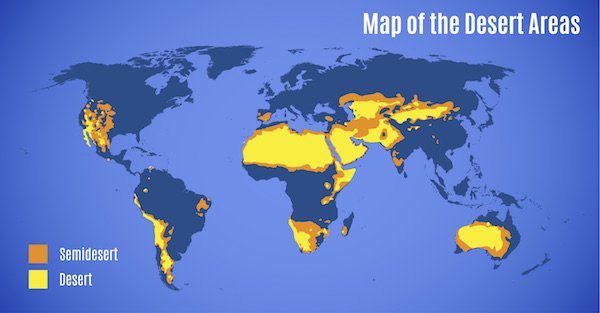
- Deserts are also called arid areas. Arid comes from the Latin word aridus and means dry, actually so dry that only few plants can grow on it.
- About one billion people live in the desert regions of our Earth. The largest desert cities are Cairo in Egypt and Lima in Peru.
- There are hot deserts such as the Sahara Desert and cold deserts such as the Gobi Desert or the deserts of our polar regions.
- Desert Facts: What is a desert? A desert is a region that receives less than 25 cm/10 inches of rain per year. In any desert or arid area, there is very little rainfall and moisture. However, if rainfall occurs in the desert, the rainfall occurs usually in strong downpours which can lead to flash flooding.
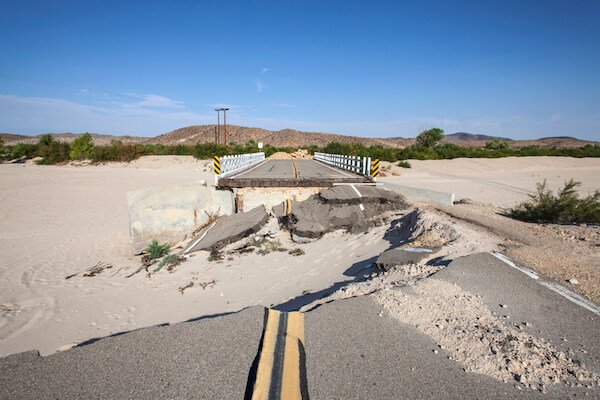
- Big differences in daily temperatures are experienced in the deserts. The temperature during the sunshine hours are usually very high while night temperatures are cold as the heat can quickly escape. The average temperatures range from 38°C (during the day) to -3.9°C (during the night).
- Animals and plants living in the deserts have adapted to the environment. Animals usually are night active and live in burrows underground six as the cajole or the fennel fox. Some animals receive their water intake from the fog in coastal deserts or store water in humps such as the camel. Desert plants often have deep roots and waxy leaves where they can store water and often they also have thorns such as cacti to deter herbivores, animals that eat plants.
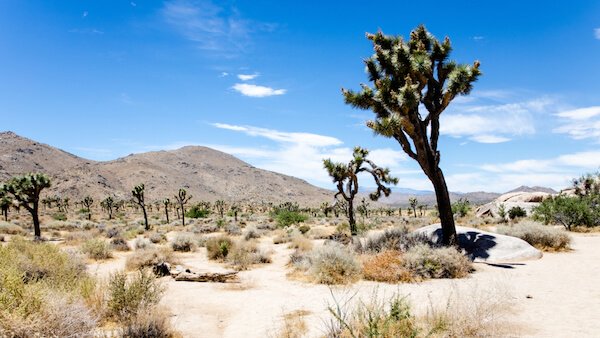
- Deserts have dry soil due to the little rainfall and moisture the area receives. Sand, gravel, mineral and other soil particles can easily be moved by wind. Deserts are threatened mainly by overuse of water and climate change as with increasing temperatures, wildfires, droughts, dust- and sandstorms occur more frequently and lead to desertification. Desertification means fertile soil become dry and barren land.
- Due to the loss of habitat many desert plants and desert animals face extinction. One of the most famous plant examples is the unique Joshua tree which is found in North America. Many species of antelopes or cheetahs that are home to the Sahara desert are now highly endangered.
12 Deserts You Should Know About
Antarctic Desert
The world’s coldest dry desert is located in Antarctica.
There is hardly any precipitation (rainfall, mist, fog, snow) in Antarctica, even rare snowfall turns into hard icy surface. There is almost no flora except for algae or mosses.
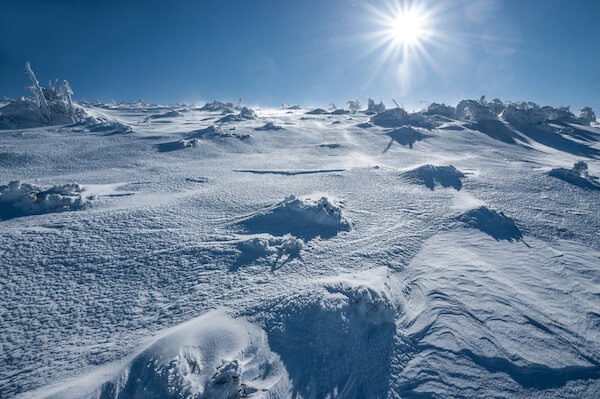
The Antarctic Desert is also the world’s largest desert by area.
Arabian Desert
The Arabian Desert is located in Asia on the Arabian peninsula and covers large parts of Kuwait, Qatar, Saudi Arabia, the UAE, Jordan, Yemen, Oman, Iran and Iraq.
The centre of the desert is the Rub’ al Khali, the so-called ‘The Empty Quarter’.
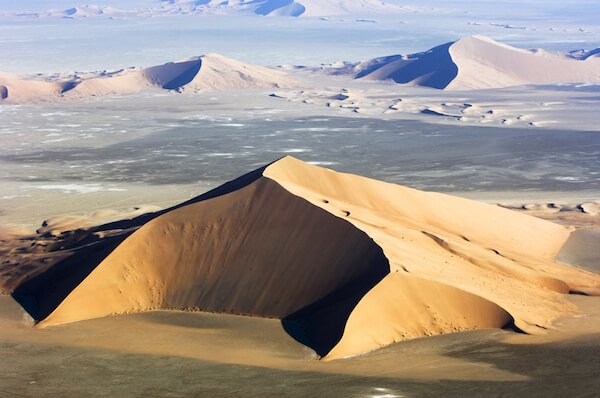
The sand here has a red-orange colour and the terrain is covered mainly by sand dunes, some gravel plains and rocky plains.
Aralkum Desert
The Aralkum Desert is known as the youngest desert of our planet.
This desert in Asia was formed by the former eastern basin of the Aral Sea in Uzbekistan. It formed in the 1960s when irrigation projects for the huge cotton plantations in the area drained the waters from the Aral lake.
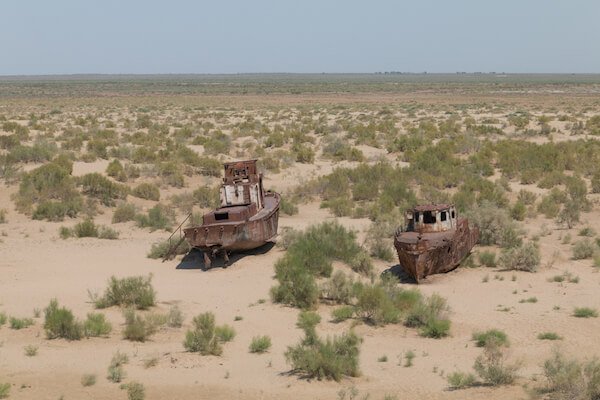
By 2014, the eastern basin of the Aral Sea was completely dried up. This desert was created purely by poor environmental management and is seen as one of the worst environmental disasters.
Atacama Desert
The Atacama Desert in South America is situated on a plateau west of the Andes Mountains along the Pacific Ocean coastline.
This desert is known as the driest (non polar) desert in the world. Some parts of the region receive less than 2 mm/ 0.08 inches of precipitation every year.
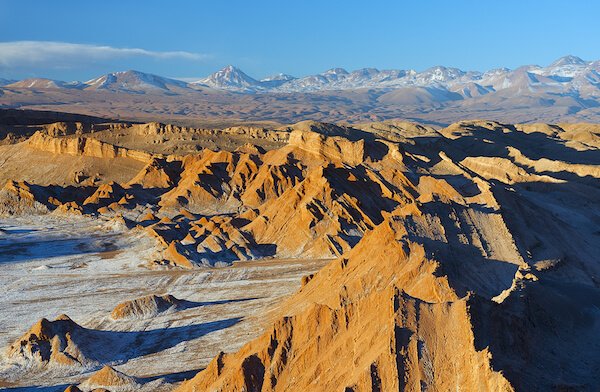
The Atacama desert stretches over 1,600 km/ 1000 miles along the coastline along a narrow strip from Chile to Peru.
Gobi Desert
The Gobi Desert is located in eastern Asia and is the world’s largest (non polar) cold desert. This desert spreads from Mongolia to China. The Gobi desert is Asia’s second largest desert after the Arabian desert.
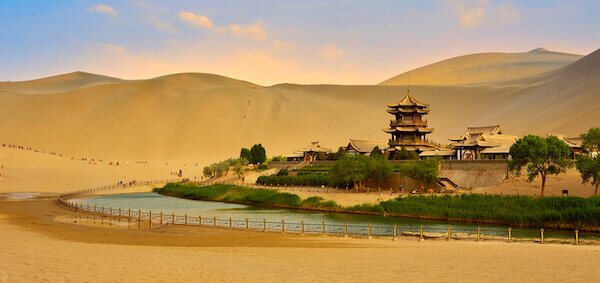
Deforestation, overgrazing and water depletion are among the main reasons this desert is growing every year at an alarming rate.
Dust storms blow away topsoil and the desert turns many previously fertile areas into barren land. The Great Green Wall project aims to combat the desertification by planting 88 billion of fast growing trees in this desert. The world’s largest artificial forest will stretch over 4,800 km/ 2,982 miles across northern China. Read more here.
Mojave Desert
The Mojave Desert is located in the USA, to the south of the Great Basin Desert and to the north of the Sonoran desert. The Mojave Desert is the driest desert on the North American continent.
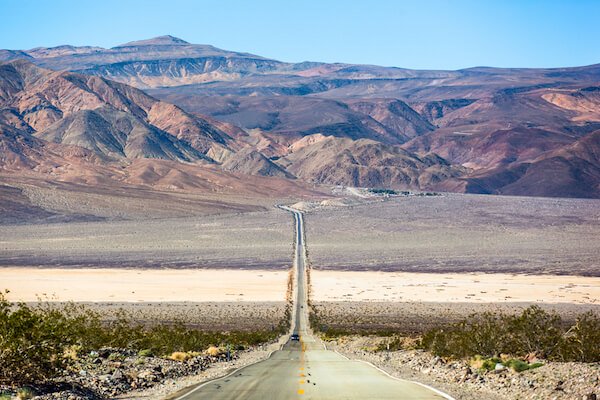
Death Valley, one of the hottest spot in the world, is located in the Mojave Desert. Mojave comes from the Spanish word for ‘place besides the water’. The largest city in the Mojave desert is Las Vegas with roughly 3 million people.
Namib Desert
The Namib Desert is located in Southern Africa along the Atlantic Ocean coastline. The Namib has some of the highest dunes in the world with heights of over 300 m/ 980 ft. Read more here.
The Namib stretches from Angola through Namibia towards South Africa over 2,000 km/ 1,200 miles.
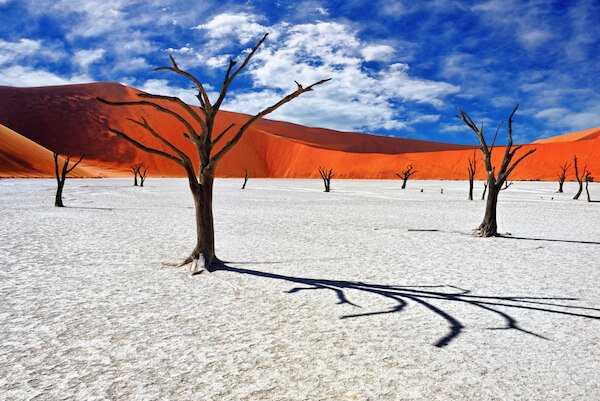
The coastal desert is also known as the oldest desert in the world. The salt and clay pans of Soussousvlei, a dried up lake, are a popular tourist attractions in Namibia’s Namib-Naukluft national park as is climbing the tall dunes along the coastal town of Walvis Bay. Read more about Namibia here.
Pinnacles Desert
The Pinnacles Desert is located in Western Australia. The pinnacles in Nambung National Park are limestone pillars and some reach up to 3.5 m/ 11.5 ft in height. Wild emus can be found in this desert.
This desert is only a small Australian desert but is known for its scenic landscape. The largest desert in Australia, however, is the Great Victoria Desert, which is located further inland in Western Australia and South Australia.
Sahara Desert
The Sahara Desert is the world’s largest hot desert. It is also the hottest of all the deserts on our planet.
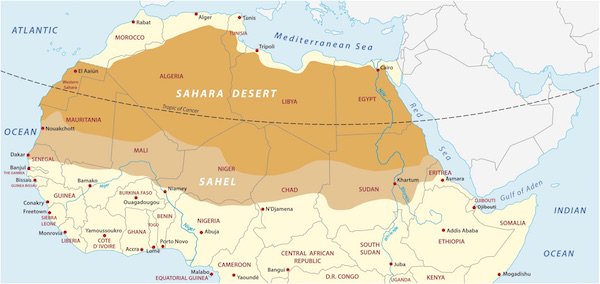
The Sahara Desert has grown more than 10% in the last century due to climate change and other natural climatic variations. A Great Green Wall project, similar to that in the Gobi Desert, has been started in the Sahara in 2007 to combat desertification.
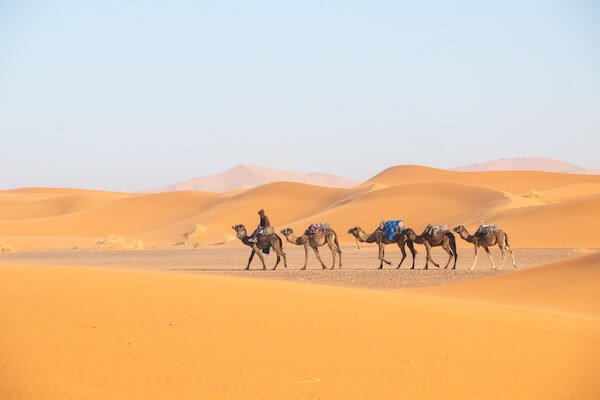
The Sahara Desert covers most parts of North Africa and is similar in size to the land area of the USA or China. The word sahra in Arabic means ‘desert’.
Huge rolling sand dunes as these in the Sahara desert are only found in about 10% of the world’s desert areas. Most deserts consist of sandy or rocky soil or salt flats.
Salar de Uyuni
The Salar de Uyuni is a desert in South America that has been formed by salt crystallisation through water evaporation of a huge salt flat or playa. The word salar comes from the Spanish and means ‘salt flat’. The salar is located in the Andes mountains at an elevation of over 3,656 m/ 11,995 ft.
This dried out salt pan once was part of a large prehistoric lake in the Altiplano of Bolivia. The salt flat covers more than 10,000 square kilometres/ 3,861 square miles and the Salar de Uyuni is known as the world’s largest salt flat. The thick salt crust which contains more than 10 billion tonnes of salt.
When it rains the Salar looks like a huge mirror measuring 129 km/ 80 miles across. The salt flats are a breeding ground for pink flamingos.
Tabernas Desert
The Deserto de Tabiernas, as they call it in Spanish, is Europe’s only desert area and located in Spain. The Tavernas are an semi-arid mountain region near Almería.
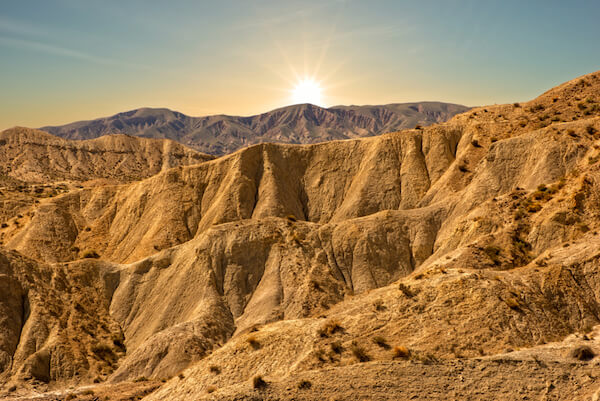
The high altitude of the region and the scenic landscape of this desert in Andalusia has been beneficial for film making. Many Western-style movies as well as one scene in the Game of Thrones series have been filmed in the Tabernas.
Thar Desert
This desert stretches from eastern Pakistan to northwestern India. About 85% of the desert is located in India and most of it in India’s largest state of Rajasthan.
The Thar Desert is also the world’s most densely populated desert area. About 40% of Rajasthan’s population live in the Thar Desert. Desert safaris around Jaisalmer are a popular tourist attraction.
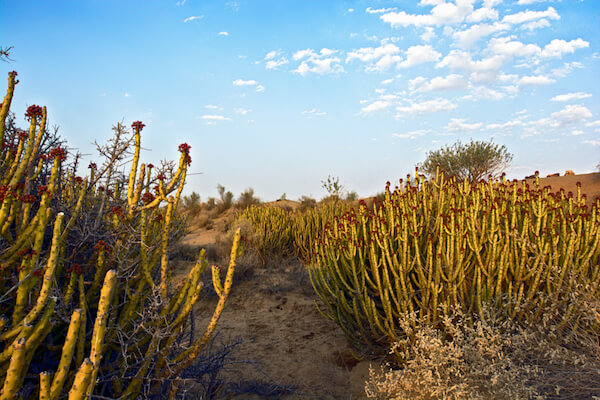
The subtropical Thar Desert is home to many species of migratory and endemic birds.
More Desert Facts
Desert Facts: Desert Sizes
The largest desert is of our planet is the Anarctic Desert. It consists of polar ice caps and tundra.
The five largest deserts by area are:
- Antarctic Desert
- Arctic Desert
- Sahara Desert
- Australian Desert
- Arabic Desert
Desert Facts: Cold Desert and Hot Desert
The largest cold desert is the Gobi Desert in Asia. The largest hot desert is the Sahara Desert in Africa.
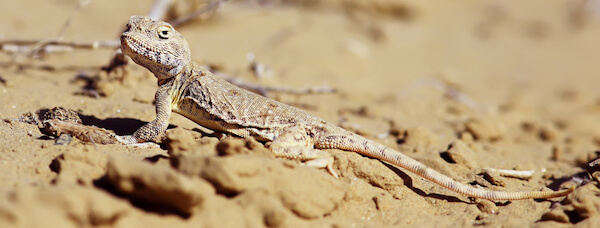
Desert Facts: Deserts and Rainfall
Did you know that desert areas receive less than 50 cm/20 inches rain per year while rainforests receive at least 200 cm/80 inches rain per year!
Desert Facts: Most populated desert areas
The largest desert city in the world is Cairo in Egypt with about 20 million inhabitants. However, the most populated desert areas are found in the Thar Desert in India. About 25 million people live in the arid areas of Rajasthan. The annual desert festival in Jaisalmer attracts desert settlers in colourful traditional dress from near and far.
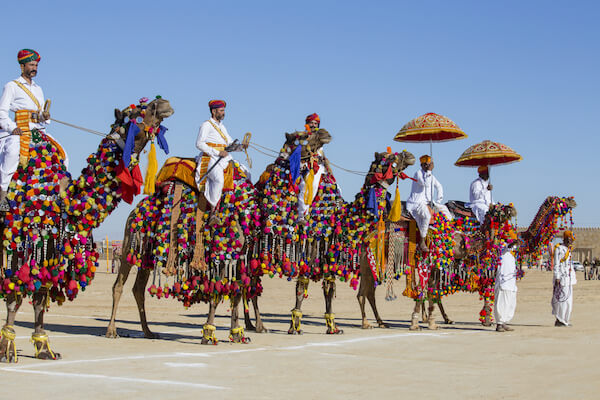
Desert Facts: Desert Vegetation
Most plants in the deserts are heat, drought and salt tolerant. Some plants store the water in their leaves, stems or roots. Some plants have very long roots to reach the ground water.
The Welwitschia plant in the Namib desert is one of these unique desert plants. They are considered among the oldest desert plants, as they are on average 500 — 600 years old, some are even 2000 years. Their normal lifespan is 400 — 1500 years! They never shed their leaves, they just grow and grow!
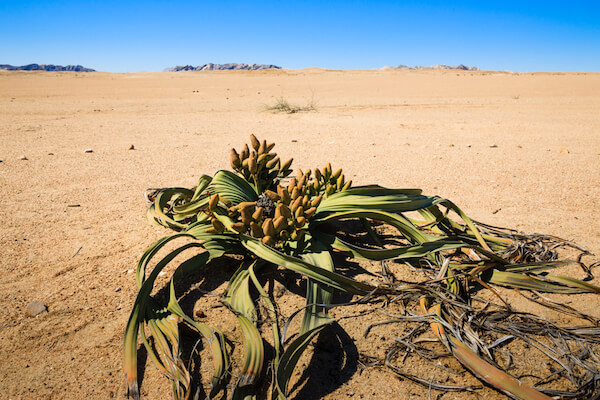
Desert Facts: Desert Resources
Natural gas, oil and mineral fields are found in the deserts however, all these are not renewable energy sources. Minerals such as gold, silver, uranium, zinc, iron, mineral salts or gemstones such as turquoise are found in the deserts.
World Desert Facts: Popular Pages
World Desert Facts Resources
- Jeannie Evers, Emdash Editing & Kara West. «Desert.» National Geographic. Last updated 19 October 2011. Last accessed 17 June 2020.
- Alice Notten. «Welwitschia Mirabilis.» SANBI. Uploaded March 2003. Last accessed 17 June 2020
- USGS. «Mineral Resources in Deserts.» USGS. Last updated 29 October 1997. Last accessed 18 June 2020.
- Yale Environment 360. «The Sahara Desert has grown 10% bigger in the last century.» World Economic Forum. 4 April 2018. Last accessed 18 June 2020.
- World Atlas of Desertification (WAD). «Convergence of Evidence.» EU Commission. Last accessed 18 June 2020
- NaDEET — Learning and Living for a Sustainable Future. «The It’s Time To… Series — Learning Materials.» NaDEET.org Last accessed 18 June 2020
- Earth Observatory. «Desert: Mission: Biomes.» NASA. Last accessed 18 June 2020
Image Credits on Desert Facts: shutterstock.com, sxc photos and own images
Return from Desert Facts to Kids World Travel Guide Homepage



